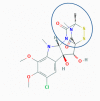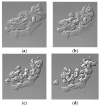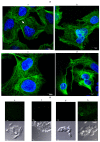Primary Impacts of the Fungal Toxin Sporidesmin on HepG2 Cells: Altered Cell Adhesion without Oxidative Stress or Cell Death
- PMID: 33670922
- PMCID: PMC7997482
- DOI: 10.3390/toxins13030179
Primary Impacts of the Fungal Toxin Sporidesmin on HepG2 Cells: Altered Cell Adhesion without Oxidative Stress or Cell Death
Abstract
The fungal metabolite sporidesmin is responsible for severe necrotizing inflammation of biliary tract and liver of livestock grazing on pasture containing spores of Pithomyces chartarum that synthesizes the toxin. The toxin is secreted into bile causing the erosion of the biliary epithelium accompanied by inflammation and damage to surrounding tissues. Toxicity has been suggested to be due to cycles of reduction and oxidation of sporidesmin leading to oxidative damage from the formation of reactive oxygen species. The current work is the first test of the oxidative stress hypothesis using cultured cells. Oxidative stress could not be detected in HepG2 cells incubated with sporidesmin using a dichlorodihydrofluorescein diacetate assay or by use of two-dimensional electrophoresis to search for oxidized peroxiredoxins. There was also no evidence for necrosis or apoptosis, although there was a loss of cell adhesion that was accompanied by the disruption of intracellular actin microfilaments that have known roles in cell adhesion. The results are consistent with a model in which altered contact between cells in situ leads to altered permeability and subsequent inflammation and necrosis, potentially from the leakage of toxic bile into surrounding tissues. There is now a need for the further characterization of the damage processes in vivo, including the investigation of altered permeability and mechanisms of cell death in the biliary tract and other affected organs.
Keywords: HepG2 cells; cell adhesion; hepatobiliary injury; oxidative stress; sporidesmin; two-dimensional electrophoresis.
Conflict of interest statement
The authors have no known conflict of interest.
Figures






Similar articles
-
Effects of sporidesmin on cultured biliary tract cells from Romney lambs that differed in their sensitivity to sporidesmin.N Z Vet J. 2018 Nov;66(6):325-331. doi: 10.1080/00480169.2018.1515676. Epub 2018 Sep 5. N Z Vet J. 2018. PMID: 30145942
-
The cellular and molecular toxicity of sporidesmin.N Z Vet J. 2020 Jul;68(4):203-213. doi: 10.1080/00480169.2020.1729268. Epub 2020 Apr 19. N Z Vet J. 2020. PMID: 32054403 Review.
-
Putative sporidesmin toxicity in an Eastern Grey kangaroo (Macropus giganteus).Aust Vet J. 2005 Nov;83(11):678-9. doi: 10.1111/j.1751-0813.2005.tb13047.x. Aust Vet J. 2005. PMID: 16315666
-
Zinc protection of HepG2 cells from sporidesmin toxicity does not require de novo gene transcription.Toxicol Lett. 2005 Nov 15;159(2):164-72. doi: 10.1016/j.toxlet.2005.05.005. Toxicol Lett. 2005. PMID: 16005584
-
Use of indirect immunofluorescence to show changes in liver actin microfilament staining in inbred mice strains exposed to the mycotoxin sporidesmin.Liver. 1986 Apr;6(2):78-84. doi: 10.1111/j.1600-0676.1986.tb00272.x. Liver. 1986. PMID: 3526071
References
-
- di Menna M.E., Smith B.L., Miles C.O. A history of facial eczema (pithomycotoxicosis) research. N. Z. J. Agric. Res. 2009;52:345–376. doi: 10.1080/00288230909510519. - DOI
-
- Mortimer P.H. The experimental intoxication of sheep with sporidesmin, a metabolic product of Pithomyces chartarum. IV—Histological and histochemical examinations of orally-dosed sheep. Res. Vet. Sci. 1963;4:166–185. doi: 10.1016/S0034-5288(18)34895-1. - DOI
Publication types
MeSH terms
Substances
LinkOut - more resources
Full Text Sources
Other Literature Sources

